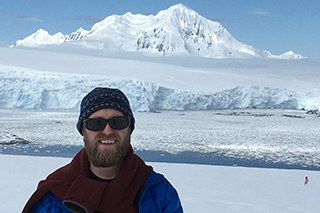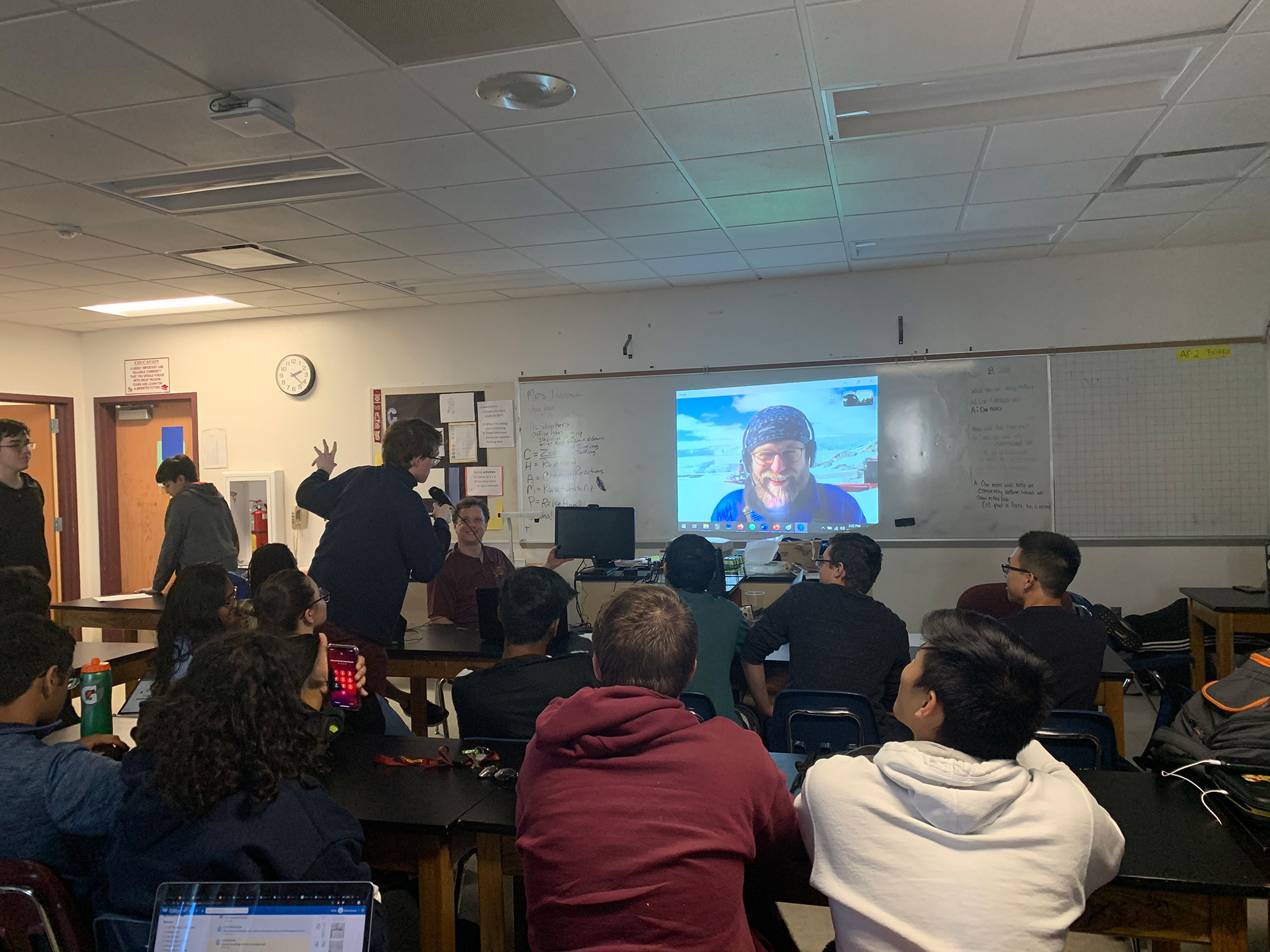College of Engineering News Room
Doing Research in the Harshest Place on Earth - Antarctica
By Brad Stager
When it comes to learning how tiny sea creatures move through water, there is no place on Earth that David Murphy won’t travel to.
That sense of purpose led the mechanical engineering professor to the National Science Foundation’s Palmer Station on Antarctica’s Anvers Island for a week at the end of 2019, where he and other researchers studied the mobility and distribution of krill, small shrimp-like crustaceans that are plentiful in the Southern Ocean’s frigid waters.
Researching Antarctic krill is another effort by Murphy to glean useful engineering knowledge from nature. His work with pteropods, which are often smaller than one centimeter in size, examines the fluid mechanics of individual sea butterflies, which are actually snails that “fly” by flapping wing-like appendages. In contrast, the krill are about two to four inches in size, are easily visible to the eye and swim through the motion of their ten legs.

Joining Murphy on the expedition were Professor Marc Weissburg of the Georgia Institute of Technology, who studies marine community ecology, and David Fields, a senior research scientist at Bigelow Laboratory for Ocean Sciences in East Boothbay, Maine, who researches zooplankton physiology. One of Murphy’s doctoral students, Kuvvat Garayev, also traveled to Antarctica to continue the research after Murphy departed Palmer Station. Garayev says the Antarctic research experience was a career highlight.
“They’re mostly transparent, and they’re just really beautiful to watch swim,” Murphy said. “Deployment to 'the ice' was an amazing experience for me. I learned a lot from the researchers that I met on the ice. Specifically, I had a chance to know more about open questions out there regarding the krill research, ranging from krill's individual swimming to schooling.”
This is not the first time Murphy has studied Antarctic krill in their home waters. As a Ph.D. student, he traveled to Tasmania, about 8,000 miles northwest of Palmer Station to do so and developed a great interest in krill’s potential for applying solutions from nature to engineering problems, known as biomimicry.
“I spent a summer down there looking at how they move their legs to swim as well as how they position themselves in relation to one another,” he said. “So, this is a follow-up to that work.”
The $197,933 NSF grant provides funds to study how krill move in large groups and their responses to various environmental cues such as light levels, turbulence, and biological markers of predators, which include about any creature larger than them in the Antarctic ecosystem.
“Everything hunts them,” said Murphy, whose graduate degrees include an M.S. in Mechanical Engineering and a Ph.D. in Civil and Environmental Engineering from the Georgia Institute of Technology. He also received an Master of Philosophy in Biological Science from Cambridge University.
Besides occupying an important place in the local food chain, krill are also harvested as a human dietary staple and for commercial processing in creating consumer goods such as nutritional supplements and cosmetics. Murphy said understanding the group behavior of krill can potentially help sustainably manage them as a resource and lead to engineering innovation.
“Collective behavior is a hot topic in engineering now, and we’re adding knowledge by looking at nature and how these krill behave when you have a couple million of them in a school," he said. "We’re asking questions like, 'Is there something we can learn about how they swim together that we can apply to swarms of drones or underwater vehicles?'”

Besides conducting research about Antarctic krill, David Murphy and his expeditionary team also demonstrated that no place is too remote when it comes to distance learning.
Thanks to the Internet, Murphy taught an advanced placement physics class at George S. Middleton High School in Tampa, 6,500 miles due north of his location in Antarctica. Middleton is a magnet school offering STEM education programs such as biomedicine, computer systems technology, and engineering.
Murphy first connected with the class when he visited their campus last year and gave a presentation highlighting his National Science Foundation CAREER award research about fluid dynamics related to the movement of tiny insects and zooplankton through air and water.
“We had such a good time with that visit that Skyping with them from Antarctica seemed like a natural follow up to that experience,” said Murphy.
For Middleton physics teacher Daniel Rice, the class opened his students’ eyes and minds to the world right around them, as well as what exists in Antarctica.
“Students were first confused by what engineering had to do with sea creatures, but then Dr. Murphy started to explain how he seeks design inspiration from nature,” said Rice. “The students realized that engineering can be more than traditional projects like bridges and circuits. The students see they can seek design inspiration from nature.”
Rice added that the class has strengthened the connection between Middleton and USF’s College of Engineering while boosting the determination of his students to succeed in a STEM field. Students were able to ask a myriad of questions concerning research, engineering, college life, tips to be a successful college student and helpful tips for student-professor interactions. He shared a reflection statement from one student, junior Milana Tatum, which read in part:
“It’s nice to hear that error and the struggles of testing persist through all the research - no matter how experienced you are - and that what I experience in my projects is normal.”
The students were able to tour the lab and a bit of Palmer Station as part of the lesson which according to Murphy was well-received by the class.
“I think one of my favorite moments was when one of the students said that Skyping with me in Antarctica was the ‘best field trip ever!’” he said.
The journey to Palmer Station is no easy trip, requiring a five-day voyage from the port of Punta Arenas in southern Chile, aboard a 230-foot icebreaker serving as a research vessel. The transit involves crossing the Drake Passage, which has a reputation for 20-foot waves and the roughest seas on the planet — something Murphy readily attests to.
“I got terribly seasick on the way down there,” he said.
While that part of the Southern Ocean is one of the most remote places on the globe, its cold waters are where large numbers of whales, dolphins, penguins and albatrosses live, thanks in part to the plentiful krill. That abundance of krill also made it possible to collect about one thousand of them with nets while underway for studying in a laboratory at Palmer Station.
While Murphy and other members of the team could conduct their research in controlled conditions, they had to ensure those conditions were comfortable for the krill, which meant keeping the air temperature of the lab and the water in the holding tank at about 32 to 34 degrees Fahrenheit.
Much of the lab work involved collecting photogrammetric measurements of groups of krill swimming in a specialized flume and recording high speed videos of individually swimming krill. The data collected will be analyzed and modeled to possibly create predictive tools about krill behavior.